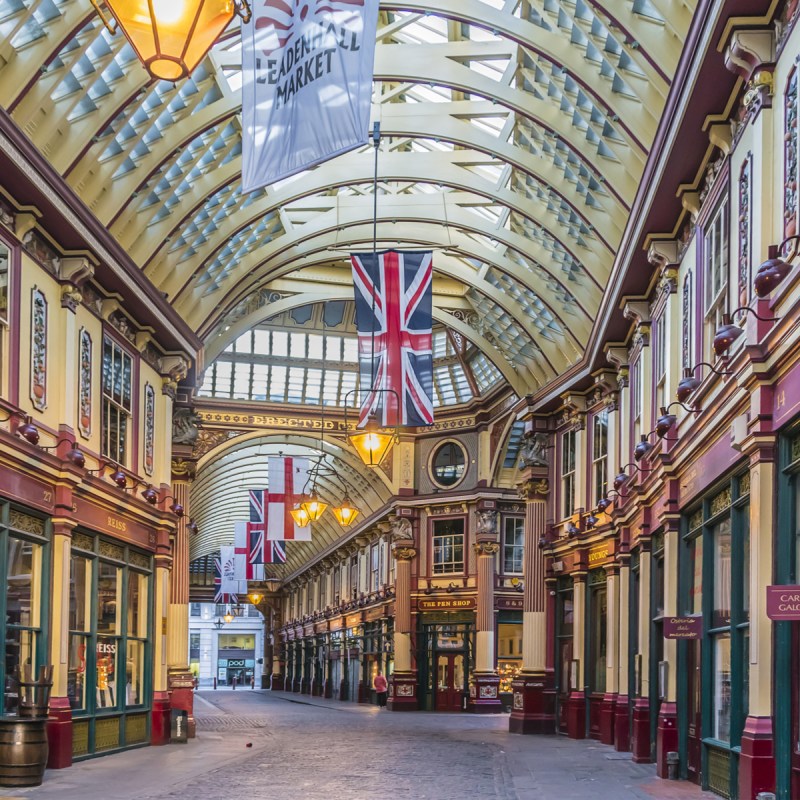
If good things come in small passages, some of London’s very best things come in tiny packages. This massive, modern city with its huge highways and skyscrapers is filled with hundreds of unique alleys, secret passageways, and memorable streets. These are much more than a footnote on your next travel itinerary. They’re little secret spots that hold onto the history of the city and serve as sources of literary inspiration and political intrigue. Perhaps best of all, they represent a real local side to London. These are the shortcuts and timesavers that residents use all the time, and lucky visitors get to follow in their footsteps. Here are some of my personal favorites to explore, along with a few recommended to me that are on my future travel list.
Videos by TravelAwaits

1. Ely Court
It’s not the most narrow and probably not the oldest, but there’s just something about Ely Court that makes it my favorite secret spot in London. It’s right next door to St. Etheldreda’s Church, the oldest Catholic church in London, dating to the mid-1200s. If only those walls could talk! As you can imagine, such an important religious building attracted much political interest over the years, including during the reign of Queen Elizabeth I. The Bishop of Ely was forced to lease land to one of the Queen’s favorites, Sir Christopher Hatton, and a tree in the middle of Ely Court is said to be the point where the Queen and Hatton would stage romantic meetings. Whether or not that happened is a bit hazy, but one “fact” that can be disproven is the story that you cannot be arrested if you’re in Ely Court. This notion dates back hundreds of years when, as part of the Bishop of Ely’s land, rules about what different parishes and councils and public officials could do was a bit murky. But rest assured, should you cause a kerfuffle in London today, the police will not hesitate to arrest you if you’re claiming sanctuary in Ely Court!
A chunk of Queen Elizabeth’s meeting tree is now in the Old Mitre Pub. This cozy pub serves up simple toasted sandwiches and sausage rolls and a small but strong selection of lagers with a few ales, stouts, and ciders on the side. It’s closed on weekends, a reflection of the working hours of its main clientele, the lawyers and journalists employed nearby. You might think, with a sign advertising that the Old Mitre was established in 1546, that it was the oldest pub in London. But it’s not! History fans will love this superb piece on how to determine what is the oldest pub in London when you take into account changing addresses, building damage (from both the Great Fire and the Blitz), and even renovations.

2. Goodwin’s Court, Cecil Court, And Leadenhall Market, Also Known As Diagon Alley
Together, these three delightfully charming streets are believed to be the inspiration for Diagon Alley in the Harry Potter book series. Alas, instead of wandmakers and potion supply stores, you’ll find plenty of history and character.
Goodwin’s Court is just a short walk from Brydges Place (below) and it looks the most like Diagon Alley to my imagination (though at least one person sees it looking similar to Knocturn Alley, Diagon Alley’s sinister counterpart). Old fashioned gas lamps definitely add to the atmosphere and local residents often get into the spirit of the place (if you’ll pardon the pun) by putting subtle Harry Potter tributes in their windows. Look for Hedwig the owl!
Cecil Court, not far away, is a shopper’s dream, as it’s filled with tiny little independent shops and art galleries. While it lacks the crooked twists of Diagon Alley, it certainly is filled with bewitching storefronts. Whether or not the Harry Potter connection here is real, there’s no denying that it’s a popular filming destination and, recently, scenes from Last Christmas were shot here.
There’s evidence to suggest that trading activity has taken place on the site of the Leadenhall Market since Roman times, and there certainly has been an established market site here for hundreds of years. But the gorgeous glass and iron structure in this covered market is relatively modern, dating to the late 1800s. It’s a wonderful place to explore, especially during the rain, and the ornate storefronts are some of the most photo-worthy spots of London. Film fans will want to make note that this is where scenes depicting Harry Potter’s Leaky Cauldron pub were filmed.
In short, these are three magical places to visit and you need not have any interest in Harry Potter to love them all.

3. Holly Bush Steps
For every well-known “secret” street in London, there are dozens (if not hundreds) of little lanes, paths, and steps that aren’t anything special – except that they’re extraordinarily special. Take, for instance, the Holly Bush Steps. In the words of Mychael Barratt, a Canadian artist living in London who counts it among his favorite walks in the city: “There’s a little pedestrianized lane that leads up to Holly Mount House and eventually around to the Holly Bush pub that I really love … the Holly Bush is definitely one of the sawdust floored gems of the Big Smoke”.
Barratt is referencing a small staircase and path that acts as a shortcut from the corner of Heath Street and The Mount to Holly Mount Street. It’s the kind of pretty pedestrian path that lets locals shave a few minutes off their walk to the pub – in this case, the Holly Bush – and stay out of traffic. It’s exactly the kind of thing that makes a neighborhood feel homey. You can also incorporate it into a bigger self-guided walk of the area which includes even more little laneways. (Fun fact for art fans: the Holly Bush pub helps sponsor the Holly Bush Emerging Woman Painter Prize.)
4. Crawford Passage
Just how tiny is this narrow lane which runs parallel to Farringdon Road in the cozy London neighborhood of Clerkenwell? Try about 5 centimeters (1.97 inches!) Technically, there’s a lot more space between the buildings than that, but the road here has been painted with the standard yellow markings of any street. As the road narrows, the yellow lines get closer and closer until there’s nary an inch between them. However, the rest of Crawford Passage looks like a normal, albeit quiet, street. Very curious! Clerkenwell is a delightful, underrated part of London and this is just one of many interesting, quirky things to check out.
5. Brydges Place
Often mistakenly described as London’s tightest street, Brydges Place is less of a street and more of an alleyway. At roughly 33 inches wide at its tightest point, this is definitely a one-way traffic kind of place! It connects St. Martin’s Lane, which is next to the London Coliseum, and Bedfordbury. It’s located just steps away from Trafalgar Square and the National Gallery, making this an easy spot to check out even if you’re only in central London for a very short visit. It’s another Last Christmas filming location. Yep, Brydges Place had a cameo in the film!
You’d expect a street this tiny to perhaps have an oversized story to balance things out but it’s really just a testament to London’s development. There had long been a road at Brydges Place when building development started in the early 17th century. Old London roads were being squeezed out everywhere but as Brydges Place connected two major streets (St. Martin’s and Bedfordbury), it managed to survive.
6. Emerald Court
The crown, such as it were, for London’s narrowest street goes to Emerald Court. Close to the British Museum, Great Ormond Street Hospital, and the Charles Dickens Museum, this is an easy street to visit, even if it’s not easy to find. You’ll have to have sharp eyes to spot the alleyway’s entrance! Overall, this is a much shorter and sunnier passageway than Brydges Place, so if you’re sensitive to feeling closed in, this would be the shorter of the two to explore. However, it too is very much a one-way traffic kind of spot and measures just 26 inches wide at its most narrow spot.
To be honest, walking through a super-narrow street like this isn’t all that interesting on its own. It doesn’t take all that long to explore! But the streets surrounding Emerald Court have a fascinating history, and there are several cool design shops. It’s well worth exploring the neighborhood in general.
Pro Tip: Understanding The Brydges Place Vs. Emerald Court “Controversy”
Determining which of these two tiny laneways is the most narrow street in Britain is a contentious subject. Where, for instance, does one take the official measurements from? There also seems to be some confusion as to how wide Brydges Place really is. I’ve seen some reports that put it at only 15 inches wide, not 26. Where can the confusion come from? My guess is that there were once some shoddy conversions between centimeters and inches and the math got all bungled. The narrowest street in Britain is Parliament Street, in Exeter, measuring just 25 inches wide at the most narrow point. In other words: If Brydges Place really was just 15 inches wide, I’m sure someone would have gone to Exeter to steal their plaque!
For more about London, be sure to check out the following:

